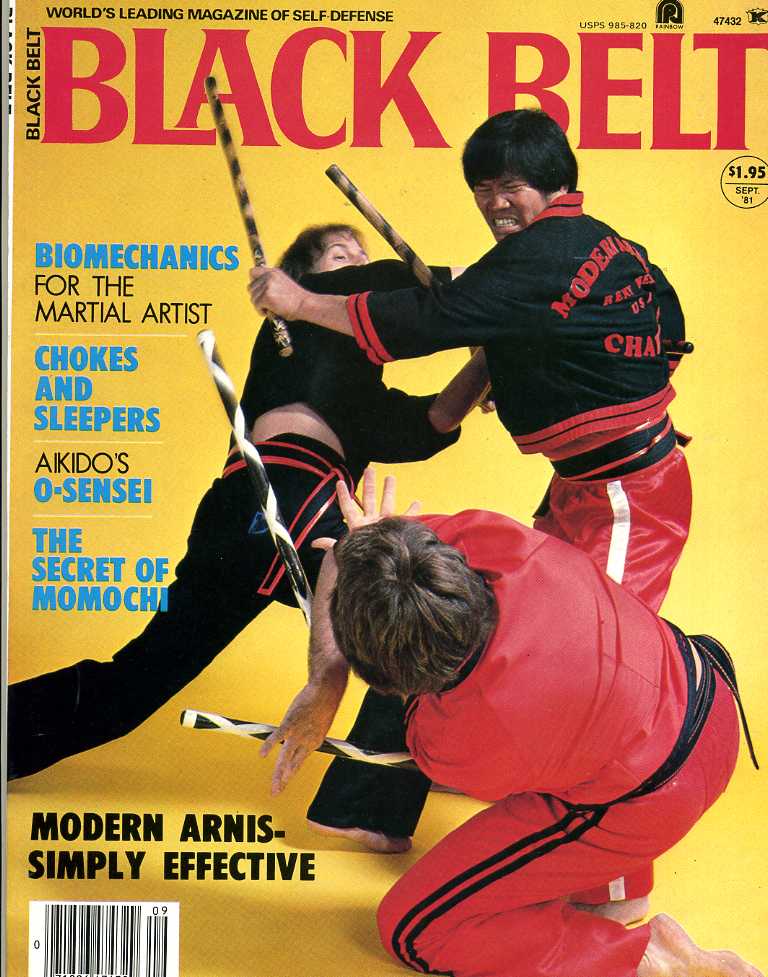
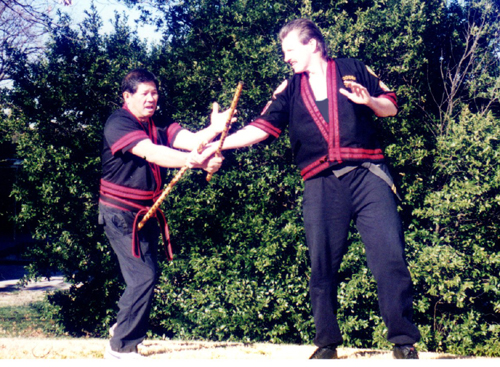
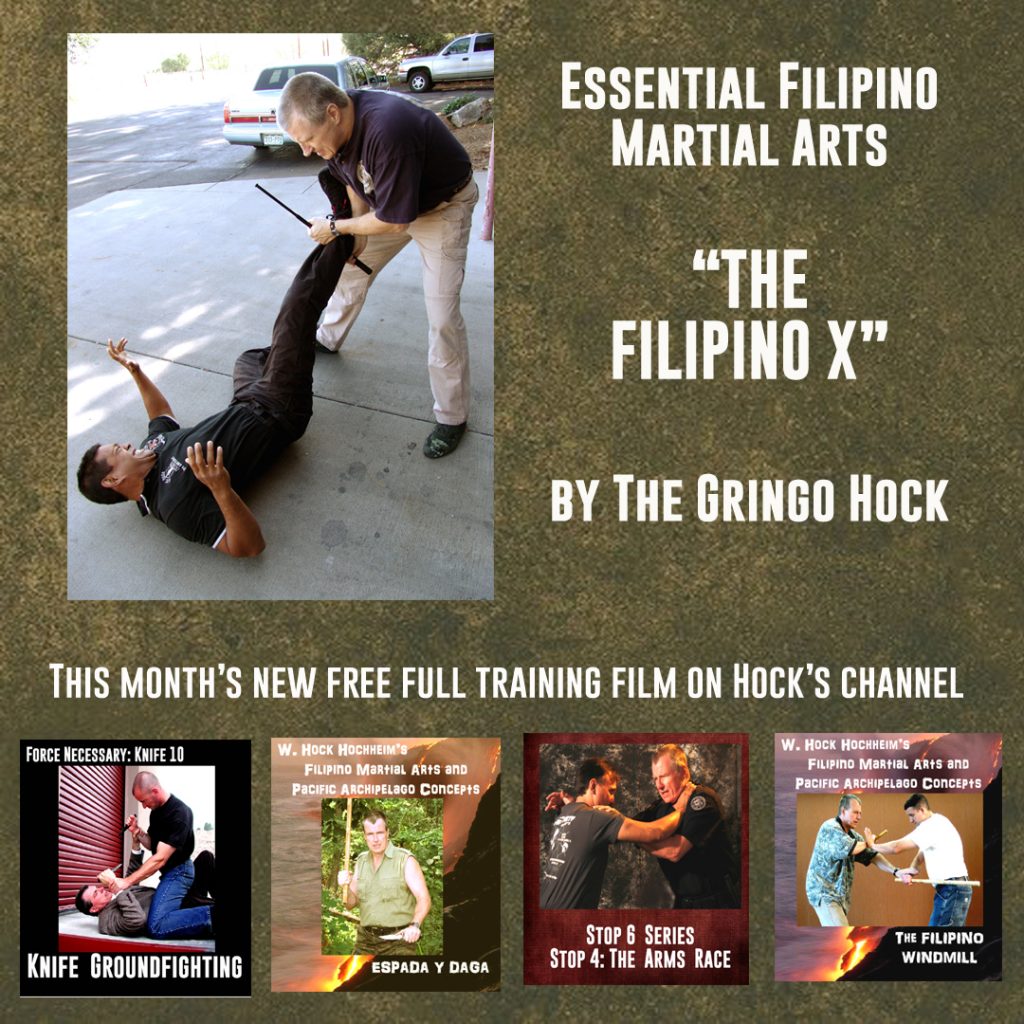



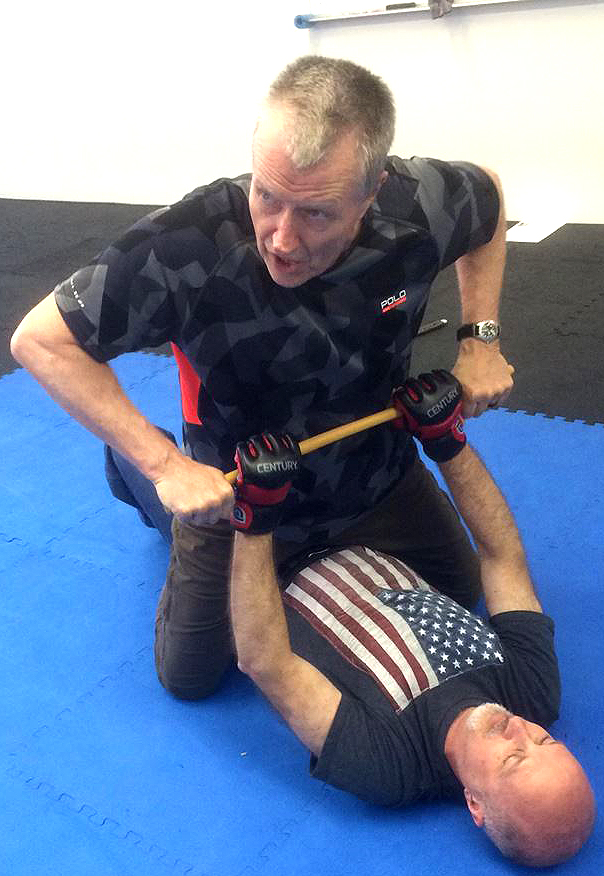
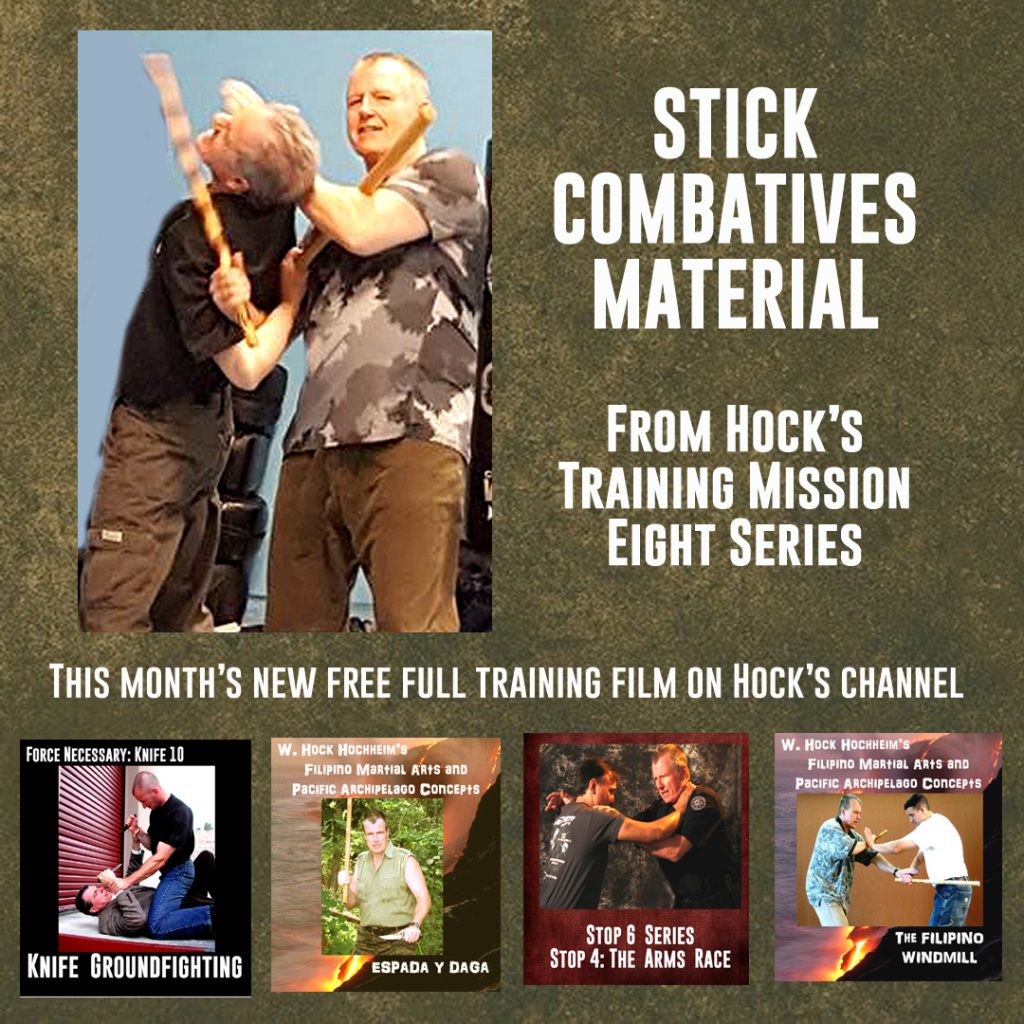
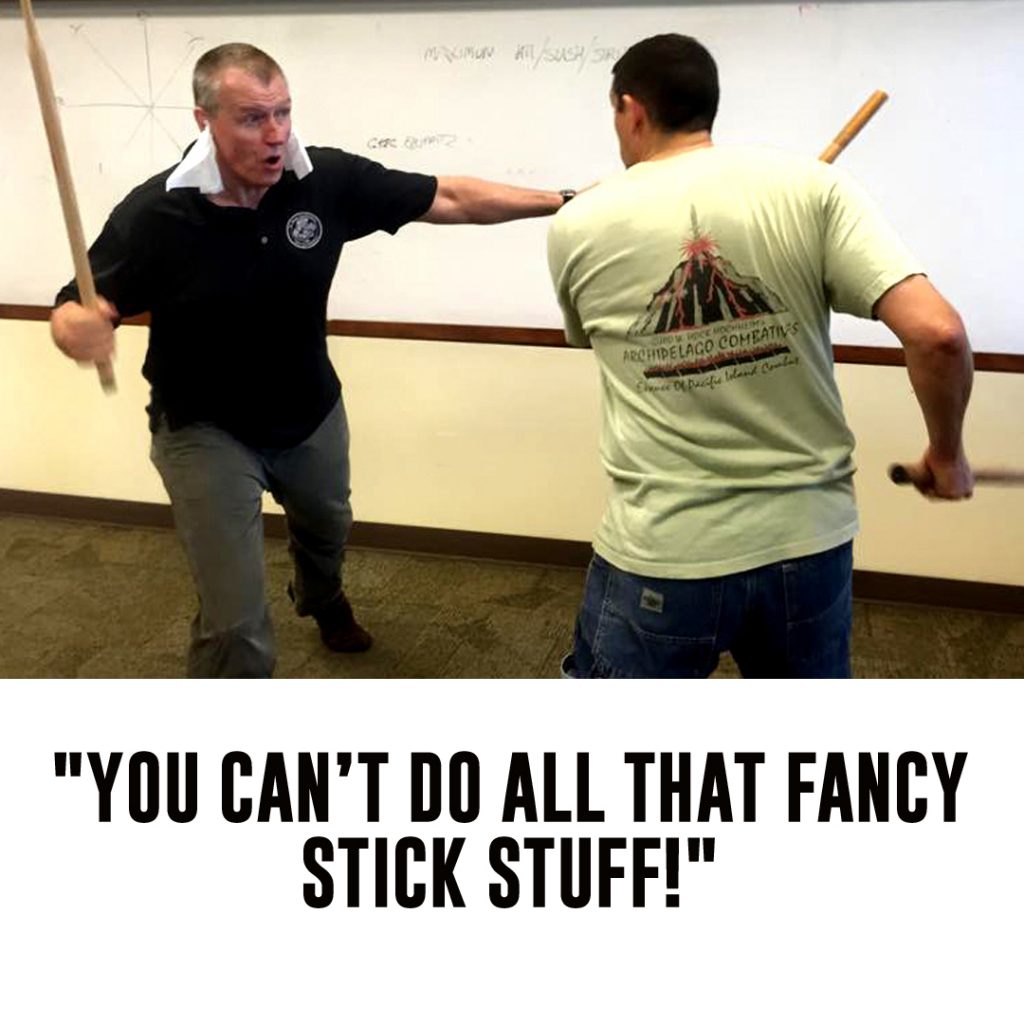 If you are a FMA “stick versus-stick-fighter,” I think, about…ohhh…80%…85% (?) of the stick material typical taught, thee so-called by many – “fancy stuff,” fancy follow-up stuff is meant for the seconds AFTER your opponent is busted in the head (no soft sticks and-or no helmets) or busted somewhere painfully vital, that will diminish his speed and brains. The head shot (or any real diminishing blow) is the missing link between sparring and the follow-ups.
If you are a FMA “stick versus-stick-fighter,” I think, about…ohhh…80%…85% (?) of the stick material typical taught, thee so-called by many – “fancy stuff,” fancy follow-up stuff is meant for the seconds AFTER your opponent is busted in the head (no soft sticks and-or no helmets) or busted somewhere painfully vital, that will diminish his speed and brains. The head shot (or any real diminishing blow) is the missing link between sparring and the follow-ups.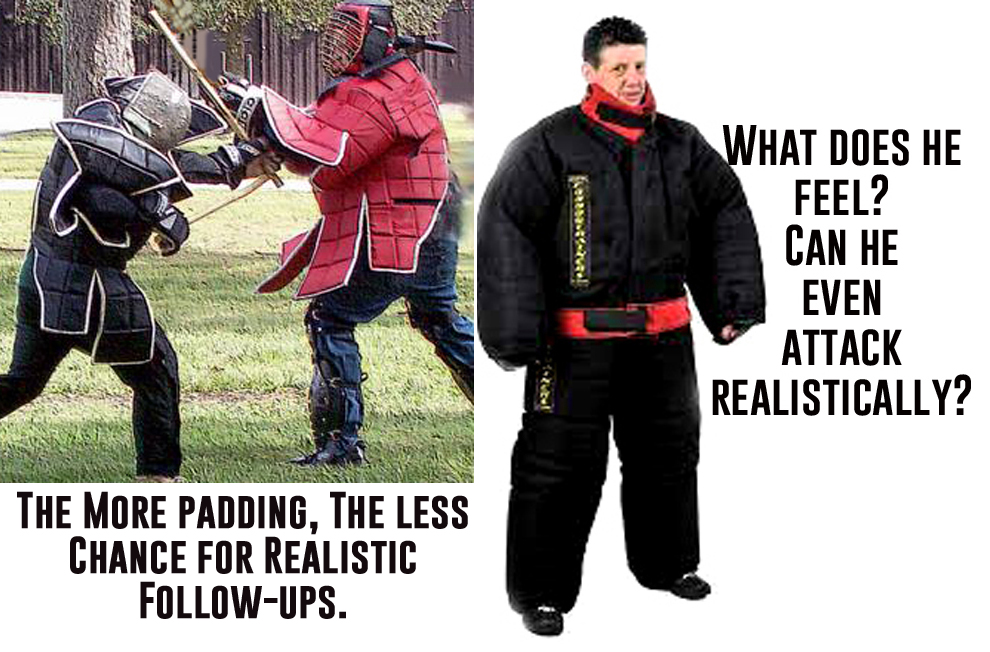
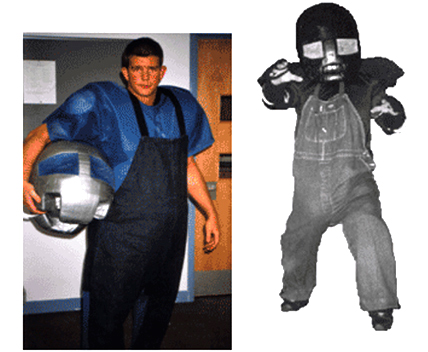
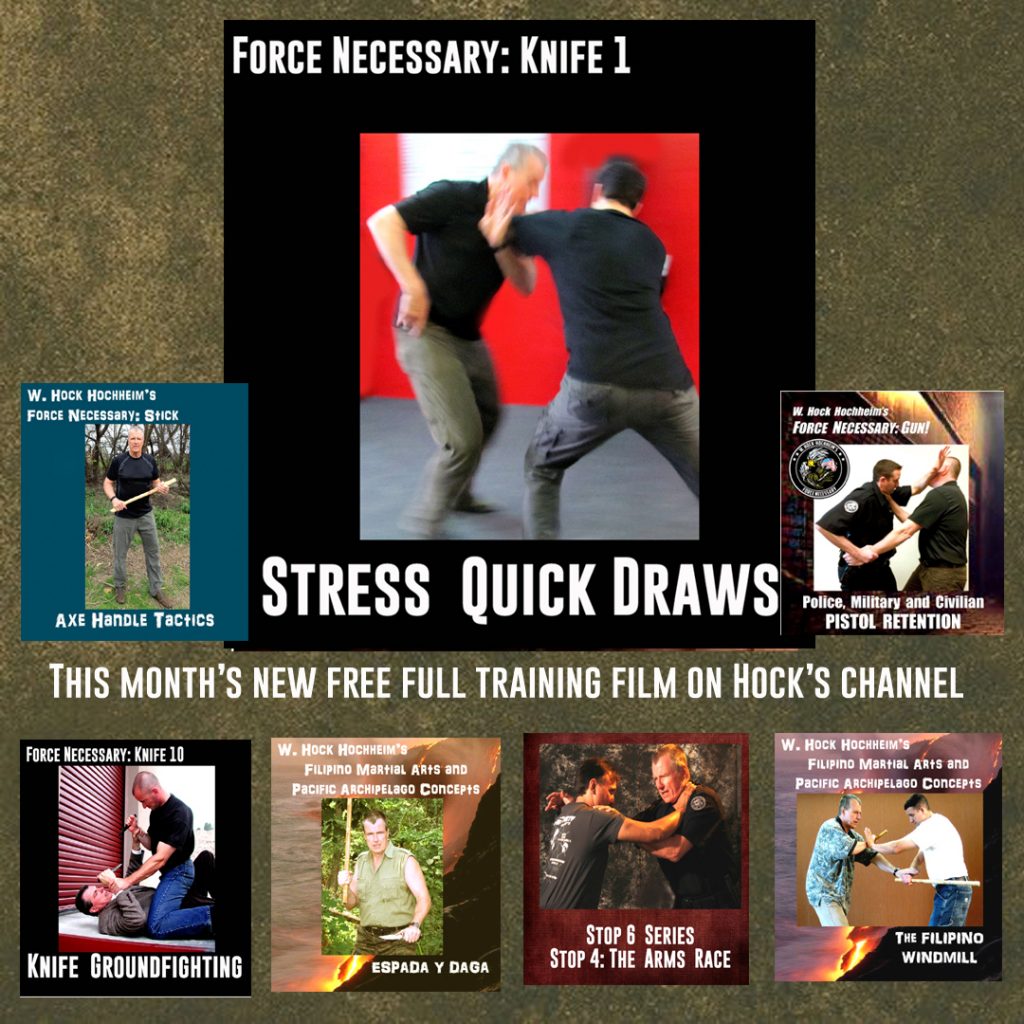
In the big picture of fast and furious, speedy, adrenalized stick fight, where does the single stick disarm exist? How can it? Let’s take a look. An important way I think for starters, is to first examine the overall Filipino Martial Arts (FMA) subject of stick versus stick disarming. I identify really only FIVE stick vs. stick disarm categories…in the universe!
Thus far for me, all the disarms in the universe, the galaxy (!) fit well into one of these 5 general categories above. Impacts and lots of circles and push-pulls, huh? Which is another way to help teach and summarize-explain the subject. List the raw movement concepts within the 5 disarm categories. Here are the three raw movements inside all the disarms categories.
I have had the opportunity to dissect and teach this list of 5 disarm categories (and their 3 movements within) around the world for years now and some, even semi-famous FMA instructors refused to believe this 5-list rendered, simplicity.
“How can it all be that simple? NO! It can’t be,” they sometimes say, “well then, what about this one?” they ask and show a disarm.
“Well that’s a strip and keep because you caught and keep this stick,” I would say.
“Well then, what about this one?” Demo…
“I would say, strip and send because shipped the stick away.”
And so on and so on, the challenges were fun to explore and always help me refine, refine, refine.
Five categories. Three raw ways to do them. Simple? Complicated? Traditional disarms are often taught and passed on in disorganized ways, usually created by artistic people with no scientific sense or teaching-organizational skills (like so many nutty katas, huh!). As a student in various FMA systems since the 1986, I have seen many of these disjointed disarm lists that miss the opportunity for smooth education, conformity and simple understanding.
For example, many disarms are glued to traditional angles of attack system. “Guro Jose” has 10 angles? And he demands – “Do this different disarm at each angle. And here they are. Memorize!” Many traditional disarms are passed along by doing…say…one mandatory disarm at their angle 5, (6, or whatever angle), when actually an angle 5 attack might be disarmed by 3 or 4 different ways. Best to pick a disarm category first and experiment doing it against all 10 angles. It will work sometimes and then not. One might call that process reverse engineering? This is a way to make your own list. Self-discovery experimentation is great, recognized, retention method.
Anyway, a search for easy, relatable explanations and mental retention must be conducted. But for many FMA systems and instructors, simplicity was-is not their mission, and after all, complexity is the fun – wow factor- cool goal. That fun, wow stuff, and-or then the regurgitation of their historic art is more important than say…the simple, sheer freedom to fix and improve things.
After the list of disarms with the 5 categories, understanding how they are executed with the 3 raw movements, it was time-saving and thorough for me to make the next list of counters to disarms. (For me, the counter study was really related to thwarting the 3 movements. What universal things could be done to counter them?)
OKAY! Quick Disarm Tip: FMA stick is primarily a play within the Rectangle and-or “X’” box, and-or figure 8 circle, areas in front of your body betwixt the two opponents. Not as many training attacks come down from straight above, or up from low-low (there are a few more low than from straight down, still not enough). How did I determine this? Just examine your system and other system’s angles of attack drills to check this. One or maybe two angles of their 8, 10 or 12 angles comes straight down from above. The rest are side-to-side thrusts or slashes in that rectangle. In Guro Jose’s system, only one angle came down from above, the other 9 were other attacks. This means his system by innocent doctrine, de-emphasizes the common from 12 o’clock high, downward attack! One out of ten. On these high and low problems…

“Hock, connect sticks high? Then force the contact DOWN to the left or right sides where there are more and easier disarms. Low? Connect sticks low? Then force the contact UP to the right or left sides where there are more and easier disarms.” (Okay! Did Moses bring that tip down on another tablet we didn’t see? It was very helpful, conceptually.)
Okay, back to making your own list and using it in sparring. Free and eclectic. You got your list! Next, can they be done fast? Under pressure? The subject of this essay! We can all do them slow, sure. But so, in the big picture of fast stick fighting-sparring, how does the proverbial stick disarm exist? Can it exist? I know a lot of veteran hardcore stick fighters and they say they hardly ever saw a semi-elaborate move. It seems that in a full-blown stick fight-sparring (but with protection-see below), all semi-elaborate moves and elaborate moves are very hard to do and hard even to see-find in usual stick sparring.
In the same way we only see…ohhh, what? Eight, ten basic, non-elaborate, fundamentals in UFC fights, over and over again, and nothing elaborate seems to manifest, because the elaborate is usually hard to insert in the world of full speed and adrenaline. (I might add the impact disarm is probably the most common?)
I have found that in order to fully understand the possibilities of disarming in full action mode, I had to cut stick fighting-sparring into two categories and understand “stun, no-stun.”
Stun, No-Stun? Protective gear or not, you can do a few more things, go a little deeper in moves, be a little more “semi-elaborate” when an opponent is stunned-wounded. (Some come to you diminished, are naturally slow, untrained, etc. like their stunned!) If very stunned? Then elaborate! Sooo, protection matters!
So, single-stick sparring within the Stun, No-Stun universe:
Stick sparring with sturdy helmets and protective gear frequently ends in grounded wrestling matches because of the protection and limited, reality stun factor. Much FMA stick-duel instruction is given under this art-sport umbrella. Stick sparring without any such gear at all frequently ends in an ambulance.
Disarms! Who or what, where, when, how and why…are you? These questions define your training mission, your end goal. They create the important nuances of doctrine (and disarming). I surmise that that many practitioners think about all or any bit of these points and just play around in the art for the wow, the fun, the hobby. Wow! Which is absolutely fine, I only ask folks…just…know what they are doing who, what, where, when, how and why.
__________
Hock’s email is Hock@SurvivalCentrix.com
Check all the free Hock FMA training films, click here
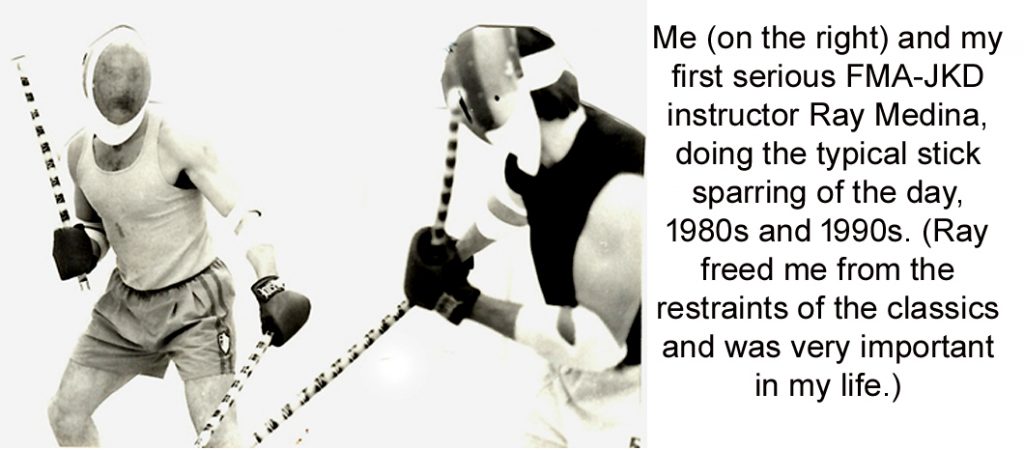 Respect the Head Shot? Do you? Really? One of the conundrums in FMA stick sparring is figuring out the realistic importance of the head shot and emphasizing it in a training doctrine. Ignoring the strike (as in “pretending” it didn’t happen and “sparring-on”) because you have a helmet on is training doctrine mistake. Making it “count” in a helmeted world is important and should be a mandatory training doctrine mission.
Respect the Head Shot? Do you? Really? One of the conundrums in FMA stick sparring is figuring out the realistic importance of the head shot and emphasizing it in a training doctrine. Ignoring the strike (as in “pretending” it didn’t happen and “sparring-on”) because you have a helmet on is training doctrine mistake. Making it “count” in a helmeted world is important and should be a mandatory training doctrine mission.

Okay folks. Bare with me. I have a few martial ranks through the years, (like a FMA, guro BB test in Manila). So, this is a joke but not a joke. I have a joke-meme I’ve passed around for years with two loaves of cut-open bread, a “white bread-brown bread” meme.
The idea is that “Joe Jones,” white boys will hardly ever achieve respected status in FMA. (I know a RARE few are, yes, yes, but most people look to and seek, foreign sources, certainly Filipino in FMA, but often settle for any American in the states with a “Spanish sounding” name. Or at least foreign sounding name. Exotic. Same is true for the rest of the planet. Think about it. Make a list and really think about it.
“The ‘hierba’ (grass) is always greener….”
And bland, white, Joe-Jones-Gringos (like me) take a back seat. This is not new, it’s a martial arts “universal.” Who wants to learn BJJ from a white boy from Finland? NO! Brazil! Or at least have a cool Hispanic or foreign surname! I’ll fall for that!
Eventually you will have to settle for a …”Gaijin” in your neighborhood. He or she may be fantastic, just not as well known, (and will remain unknown, which is actually the whole point of this essay).
All this is just the subliminal (and overt) marketing of life and what we seek out, like Chinese food, or Italian pizza and who makes makes the best cars? Germans or Japanese? Are ex-cons the best street fighters? Do the Israelis have the best military fighting system? Is Silicon valley the best source for all things tek? Why pick the Marines over the Army? People should recognize natural and man-made…”lures.” Who has the “best” story for what? And why? What then, catches our fancy? What do we gravitate to?
In fact, when I think about it, I have felt like a white boy (and-or wrong religion) outsider in most martial arts I’ve ever down, with all the real leaders always from elsewhere, Japan, Philippines, Indo, Russia, Israel, China, the sewers of Spain (gag)…the popular systems and arts are always from elsewhere. And me? Always the…gringo. This though I expected, it’s just an observation on martial life.
Anyway, there were numerous viewers of that “bread” meme on various pages, some very smart and substantial folks, and they laughed and liked it when I half-joked that I might therefore just call myself “El Gringo,” as part of an FMA business nickname, (I still teach FMA here and there around the world along with mostly combatives.) Just a fun, name-game and partly a bit of satire on all those grand, tuhon-guro-supremo-GM master titles that keep inching up like bamboo. For 26 years now, I just tell everyone I teach to call me “Hock” and remain on an equal, friendly footing as I believe system-head-worship is confining and not good for evolution. Bad for some of my business, but good for your evolution and freedom.
Some attendees-students still insist on titling me. It’s a tradition, you know. If you must call me something? Truth is, I’m just a gringo, a white boy, outsider from Texas who knows a few tricks of the trade. Tongue in cheek? A satire on the name-game? For FMA…call me…”EL GRINGO!”
“Out of the night, when the full moon is bright, comes the stickman known as Gringo. This bold renegade carves a “G” with his blade, a “G” that stands for Gringo.”
(Sung to the Zorro TV theme with apologies thereto. I realize the great young, unwashed has never heard the Zorro theme song. Never saw the old show. Too bad. Then feast! Feast on this video! https://www.youtube.com/watch?v=lQnle_3KuOE
________________________________________
Hock’s email is HockHochheim@ForceNecessary.com
Check out the PAC-Filipino page, click here
A Bigger Picture. In the martial arts world, stick versus stick fighting is most closely associated with the Filipino Martial Arts (FMA). A huge chunk of many FMA systems is indeed about the stick-versus-stick duels-events.
(Using-hitting a stick is an easy and fast training target, as with developing the smart fanning strike shown here – the abaniko. This is not necessarily learning how to stick duel, but rather learning to strike with a stick versus anybody with or without anything with a one-two-there fanning spin.)
To establish my opinion here, I remind that I have spent decades in FMA and decades in very generic combatives. Some people around the world think I am knowledgeable on the subjects, so here goes.
The best FMAs I’ve found spend equal amounts of time in what GM Ernesto Presas defined as “the 5 major areas of play” –
Equal time for the five? I find that some FMAs spend disproportionate amounts of time with sticks. Just look at all the group photos of FMA seminars. Everyone is always holding sticks. Sticks, sticks, sticks. Sticks have become the avatar for FMA. Sure it’s fine for some hobbyists, addictive even, whatever, but I “stick” with the Ernesto Presas “Big 5” format.
I am so often reminded of the classic Ernesto Presas quote, “The cane is the extension of the hand,” suggesting that the hand comes first. Dan Inosanto, so often pegged an a consummate FMA-er always does a plethora of other arts than being stick-centric. Too much stick gets FMA redefined to the “stick-only art.” It ain’t! It’s so much more.
Is this dueling calculus necessary in the real world? Through my decades of policing, training, cases and rather obsessive research, I have personally run across a few impact weapon “duel-related” battles like drunken, softball bat fights at tournaments, or crowbar versus tire iron fights. Things like that.
Stick dueling.Otherwise No. Almost all of us are highly unlikely to get into the proverbial 28” stick versus (coincidentally?) another 28” stick fight in a real world, dueling “street fight.” A study of the stick in common self defense should not-would not be centered around a mirror-image-fighter, stick-versus-stick dueling material. Secondly then, all this stick-trick trapping after longer range contact? No. Not this much. Obsessing with stick dueling and stick trapping should be relegated more into a category of fun, art, sport, hobby or exercise, with only abstract benefits to self defense.
While dueling helps various abstract attributes, there are indeed smarter things to do, to prep for a fight in crime and war. When you remove stick-versus-stick dueling and the calculus of stick trapping from FMA systems, there is so much less to worry about and train for survival. While It is vital to FMA, but even in FMA, there is always other stick things to work on like stick-versus hand, stick-versus-knife, even stick-versus-various, gun threats. Now we are looking like self defenders.
I am asked to teach FMA with some frequency and I do so with a great big smile as it is one of my fun interests, but I always make this quick lecture. As readers know by now, I preach the “mentality, hand, stick, knife, gun, mixed weapon, matrix.” And while my Force Necessary: Stick course must touch a bit on the impact weapon duel – because it has and can happen – in no way do I emphasize it. And a great many folks emphasizing self defense and combatives agree with me on this.
Watch out! These “reality” people are “window-peepers, peeping in your school windows, watching you on Youtube.” quick to judge what you are doing and pigeon-hole you as artsy and off-mission Arnis versus reality. Which leads me to the name-tagging quandary.
For self defense combatives, the trainer and trainee, the work-out partners should still both often hold sticks sometimes. Sometimes? In stick training, it is much easier and faster for both partners to hold sticks for various goals. You do, I do, You do, I do. Ease, target practice and stick blocking to name three.
(Target practice! And you can hit hard. He can learn to block well too In the FMA world other Arnis-Kali things happen.)
So even if you are a self defense, combatives person you might find yourself looking like an FMA-er when both the trainer and trainee hold sticks and appear to be doing “too much stick versus stick” to these short-term window peeper-complainers. But still, dueling is not your real, end mission.
In summary, a few quandary warnings to think about…
Obviously I use an impact weapon emphasis in my Force Necessary: Stick course (details listed below, the self defense, stick matrix,) but I do not overdue the stick versus stick aspect when covering that course. FN Stick looks like this:
When teaching FMA I try to do everything but in equal proportions.
Hock’s email is Hock@HocksCQC.com
_____________________________________________________
Get the Impact Weapon Combatives book, (the new second edition!) Click here
MMA – Mixed Martial Arts? Or MMA – Mixed-up Martial Arts?
The tabulators tell me that 2021 this will be my 51st year doing martial arts – having started in Parker Kenpo in late 1972. I’ve always 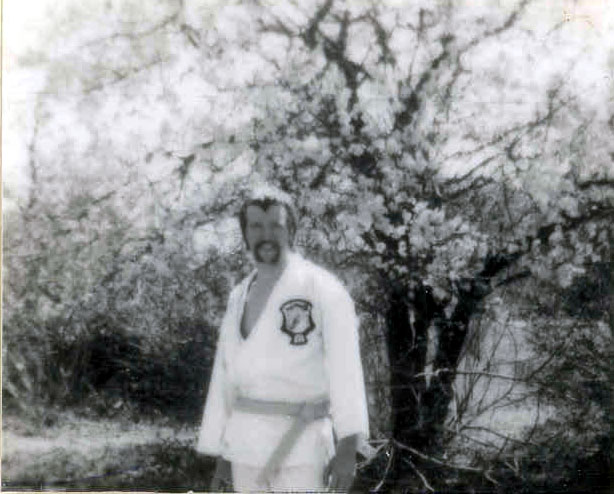
From the 70s on I was working out with what was available, old school jujitsu, boxing, karate, police judo-defensive-tactics. Then in 1986 I starting with the Inosanto Family systems (Thai-JKD-Silat-FMA-Shoot fighting) and Presas Arnis. In 1990 I started Aiki-Jujitsu with a professor in Oklahoma. I guess I was spinning a whole lot of plates? But on some level, despite the differing outfits, patches and the nomenclatures, many times I noted I was often doing the same basic, good moves in different systems, despite the change of systems with a tweak here and there. Sort of a name-game change.
Makes me think of the Bogey movie song, “You must remember this, a kiss is just a kiss, a sigh is…” But you really must remember that a 
I see my martial life that same 1, 2, 3 stages way that Mr. Qingyuan suggests, which leads me to my mixed-up-martial arts phrase and phase. Bear with me. You might see yourself in this dharma-dilemma-development?
For quite some time I played a name-game switcheroo. I changed clothes and mindset with various martial art class scheduling. Often in the same night! I can best describe this with two quick stories.
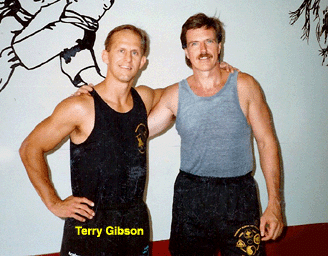
Each of the classes definitely had a different mission, feel and goals. I’d got the vague idea back then that these things could be blended, especially via the Bruce Lee ideology I was trying to grasp, 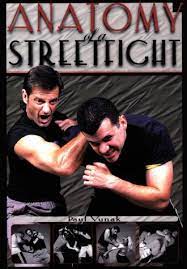
By the way, this division of subjects is a martial arts school business model. More classes. More themes. More students. More outfits. More testing. More money. Nothing wrong with that – just saying. With many other instructors and schools in this business model, we studied to become one system-artist when doing that one system-art. MMA, the evolved business model became closed studies to learn different things – yes – but, inadvertently, keep them separate. Divided. Which, whether I fully realized it at the time, was NOT what I wanted, but I wasn’t quite “martial-mature” enough to realize it. I had no “eye” for it. (More on “eyes” later…)
I used the Who, What, When, Where, How and Why questions.
While turning the all-mixed-up to the mixed-blended, I have a lot of teaching stories for each “W and H” question from these last 26 years, the second half of the 50. I believe these to be informational, entertaining and educational stories, but book-length, and not good here for a short blog.
It should come as no surprise that in the big training picture, modern MMA (as in a blended “UFC style” With ground n’ pound, and I repeat WITH ground n’ pound), Combatives or Krav Maga formats evolved to fill in that anxious, wandering market place of folks like my early self, seeking the stripped-down blend, the best mix. It’s just business and filling the gaps. “Nature abhors a vacuum,” as they say.
Something much bigger is going on though. In the history of mankind, its overall DNA, a small group of people – us – struggle to keep fighting skills perpetuating, alive, for the drastic times that come and go, and keep us all alive. This genetic drive manifests in many different ways, like karate or combatives. It’s that big picture, so big we don’t see it, down to the smallest of pictures. You. You and the quizzical questions and choices in your head. Why do you do this stuff? Well, I just gave you one big DNA reason you might not have thought of. For some of us? It’s our inherent duty to mankind. We are the odd, weird ones, keeping this alive.
I certainly don’t regret all the mixed-up, past exposure, the blood, sweat and cussing since 1972, even though I wanted simple, generic hand, stick, knife and gun. But still, the background-depth, time and grade, experience is irreplaceable. Mike Gillette said once, “you are really paying Hock…for his eye.”
His eye? Eye? Look for a moment at my Australian friend Nick Hughes, currently in North Carolina, USA. Yeah, he teaches Krav Maga, and yeah, so does every Tom, Dick and Henrietta these 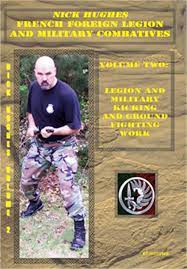
I often peruse the internet martial arts pages and I read stories of 25, 30 to 45 year old martialists and martial artists and their compulsion to publicly write – as one might in a personal journey or diary – about this or that small martial epiphany. Been there, done that, kid, and I quickly get impatient and bored with their tales which is my flaw, because I have to remember everyone is on their own splayed and fileted journey. Their mission, however on or off it might be.
What is your mission in this dharma-dilemma? Are you…”martial-mature?” How’s your “eye?” Look, I want people to be happy. Do what makes you happy, sports, art, combatives. Mixed? Mixed-up? Fun? Comradery? Whatever. People even like all kinds of mixed-up, martial arts to fool around with! Just know where it all fits in a big picture. Your big picture.
The teacher’s curse, “Survival? Or addictive hobby?” “In the martial arts world – There is so, so much to do and so, so much of it is addictive, but so much of all that addiction is extraneous, superfluous, abstract, distracting and unnecessary. Yet still this curse – the mandatory basics become boring, no matter how utterly important it is to utterly master them and them alone. It seems we will never stop wrestling with this fight against boredom. The “art” of the survival teacher is to find the best, reduce the abstract and somehow trick-hypnotize-engrain the student into doing it…first, foremost and forever.
You can use your mature eye to take the “mixed-up” out, and to leave “mix” in. You can take things from a martial art that has a high percentage of success and NOT take the whole damn system. Or not? Just don’t be…off-mission, off your personal mission. In the mixed up, forked roads of martial dharma – the “eyes” have it.
____________________________
Hock’s email is HockHochheim@ForceNecessary.com
A lot of American football coaches and players watch game films. I instead, have watched hours of football “how-to” training films to see how these players TRAIN. If you have ever spent time with me, you’ve heard me brag for years, decades even, on how American football training methods can be diced and altered to enhance, inspire and supply power-contact exercises for martial fighting. You’ve heard me say that a knife fight might not look like a movie duel, but might instead look like “football with a knife.” Same with sticks.
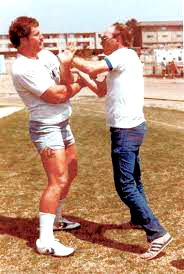
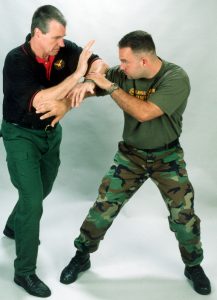

So, I take a hard look at football, hand drills-methods that enhance all that. The of quality football players, starting at college on up, is record breaking incredible now. These increases come from several methods, but two methods are clever drills and exercises for functionality.
One Quick Observation in and around on this subject. Australian football – or “Footy” is tough as hell, and like Rugby, sort of like soccer, are “chase-games” without the consistent line of scrimmage collision battles that can be reminiscent of, and can resemble a common collision in a fight, crime or war. Every football play starts with what a chiropractor might call, a small car crash.

Second Quick Observation in and around this subject. A fad move today is teaching an arm drag to get outside of an opponent’s arms and then pivot around them to get a rear bear hug. In demos and seminars, many “show-ers” just…just end right there with the rear bear hug. They show no more. Huh? They stop there, as if, with the bear hug it’s…over? Nope, it’s just getting started. Yet naïve rookie, seminar attendees (usually gun guys exploring unarmed combatives) think its manna from heaven. Some instructors will show a follow-up. They demo a bear-hug follow-up solution and they will lift up and body slam the opponent to the ground, of course falling with them too, to enter into the world of non-stop, one-dimensional wrestling. Such is their brain-washing. Usually both these demo people are 30ish-year-old athletes. But when we look around at ourselves, at each other, differing sizes, ages and strengths, is a 150 to 250 pound body lift and body slam of the enemy practical for the masses? Hell no. I can’t pick up, least of all, body slam a 175 or 200 pound person! And anyway, I want to remain up as much as possible.
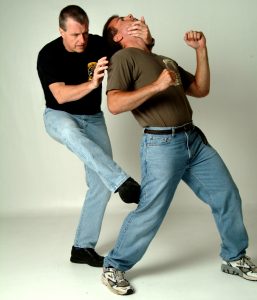
A Third Quick Observation in and around this subject. American football obviously deals with face-to-face, frontal to frontal tackles, and not always chase tackles. They also cover power drills with pads to counter tackles, done in clever ways that any citizen should try and would enhance the subject, beyond typical martial arts classes.
In Summary, The Problem Is, His Arms! They are almost always are in the way. And they have muscles and seem to have a “mind of their own!” Here is a fast, short list of some football training drills I have collected on trapping and the “Football-Hand-Fight.” I can’t put videos in a book so I have to share them here. They incorporate Stop 3 Forearm Collision materials, and Stop 4 Shoulder Line collisions. Would you watch them for training ideas, adaptations, and inspirations?
For more diverse training…
HANDS-LANDS – Touching the “hands” of the master. Touching the “lands” of the master. Hands-Lands.
(This was a spirited discussion on FMA Discussions. Many say you MUST go to Philippines to “get it.” Many say no. Not needed. I said…)
I started attending Remy Presas seminars in 1986 and I was just another person in the crowd. One attendee was also an Ernesto Presas guy who asked me if I knew Ernesto. I did not and he pulled me aside into a curtained-off meeting room from the big seminar. Two others were there too and we started doing Ernesto stuff. This guy trained me in Ernesto’s material for years, which is different than Remy’s. Four or five years later we wound up in the Philippines. Once back in the USA, at the next Remy seminar, attendees told Remy I was over there for three weeks and even stayed at his old Negros house, etc. He liked this, called me over and wanted family gossip and so forth and only then did we made the solid connection, because he knew I was THAT committed to go over there. I started hosting Remy for years, etc.
Later at a Remy-Dallas seminar at Steve Selby’s school, Remy made a speech about training and with whom and “Touch hands with the master,” or as he would say it, “Touch hans’ TO de’ master.” He pointed to me and said, “Hock has gone twice to de’ Philippines already. I don’t know why? Because…I am here!” Everyone laughed as did I, shaking my head. You could tell by his smile that he making a joke. But why go?
The pro-go Filipinos in the FMA Discussion seem to want you to see the lands, walk barefoot on grounds, breathe the air, eat the food, dive deep in the history otherwise you won’t really “get it.” Like live there? “Going native” – is “to adopt the lifestyle or outlook of local inhabitants. Furthermore, must we also “go native” with all these martial arts we take? While Bruce Lee said all these things were just “Kicks and punches,” must we go down a national rabbit hole and become Colonel Kurtz? I went a little native in South Korea. Lived in the village, etc, but didn’t become a Kurtz. The military grants you time and grade in obscure locations, otherwise you are in-and-out tourists.
Tourists. I often look at folks traveling to the homelands of their martial arts. So many go to Okinawa, Tokyo. South Korea. A friend of mine even went to NORTH Korea for a Tae Kwon Do pilgrimage! (He said it was scary.) All serious Thai Boxers go to Thailand (although in my “heyday-times” of Thai -1990s- many also went to Scandinavian countries for Thai). I think it’s a pilgrimage some want to take. I think it is situational and circumstantial. After my P.I. trips, we got Ernesto coming over the states with gigs and the P.I. trips were long and expensive for me (and my job). The circumstances, the situation, the need was over. But I will confess, me having “gone over” several times was a big marketing help for me.
People like to travel and touch for really unique reasons, lest of all over martial arts. I have a good friend in England who worships the Spaghetti Westerns of Clint Eastwood. He and his wife visited the small town village in Tabernas Desert and the Cabo de Gata-Níjar Natural Park in Spain where they were filmed. He has small glass jars of the sand from there as souvenirs. The human drive to visit.
Look at all the people running to Israeli for religion and Krav! The Japanese see Americans going over and dressing like they are ninjas and they laugh. One Japanese-American told me it would be like Japanese coming to America and dressing up in Civil War clothes and taking part is a Civil War recreation. WHY!?
I like for people to be happy and if they want to go, and afford their journeys if they can and should go. I would like to go to Frank Sinatra’s house in Palm Springs. I might not get a glass jar full of booze, but I would like to sing a song there in the backyard.
What of the name-game and FMA? This is actually a whole other FMA discussion subject, somewhat related though, but the real success stories in FMA, those with sought-after instruction and with bigger groups are really all Filipino people. Or they have a name-game-stretch-connection, with Spanish or exotic sounding names yet have never gone to motherlands. Dan Inosanto, a real important FMA pioneer, has never been to the Philippines that I recall. How many land-locked, Americans just have exotic foreign names and have large groups? (They could be good or bad but still get the immediate attention.)
Even though I have been over there – this is why I do not flash myself around as some kind of special super-duper, FMA Person. I will never be an FMA real deal. I am happy to help others get an understanding, etc, if they are interested, but I am just a white boy in Texas. I can only think of a very few white boys with consistent, international FMA success, oh like Bill McGrath and Deiter Knuttel from Germany. Otherwise you gotta’ be Filipino or have a Spanish sounding name and,or seem to be Filipino or could be Filipino. Or else, you better be seriously attached to one. The truth (skill) bears out later.
Origins and names…this is a universal, martial idea-draw. As a parallel, looking at ads and videos would you want to take Brazilian Jujitsu from a Tim Smith? Or a Jose Gonzalez? Who has the immediate advantage? Most would instinctively go with the Jose. (Makes me think, speaking of other parallels – how many Yankees are going down to Brazil to learn BJJ, to go “native” in that native homeland, or have all the experts moved up North?).
On “Going native,” furthermore, must we also “go native” with all these martial arts we take? I do think back through the years of Systema people getting so wrapped up in it that they started becoming communist. Posting pictures of Putin and remarking in pro Russia statements. How some Silat people became Muslim? And then even radical Muslim. I’ve seen it. Krav people becoming Jewish. Like Bruce Lee said – all these things were just, “Kicks and punches,” must we go down a native rabbit hole and become Colonel Kurtz? Studying how to kick and punch should not ordinarily alter your politics and religion.
Touching the “hands” of the master. Touching the “lands” of the master. Hands-Lands.
__________
Hocks email is HockHochheim@ForceNecessary.com
Don’t let this photo scare you! Click here and check out the PAC-FMA streaming videos
#marlonbrando #apocolypsenow #franksinatra #spaghettiwestern
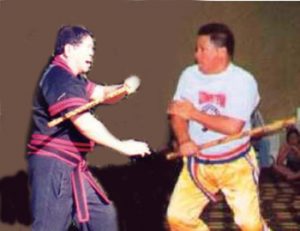
I was thinking about the classic park in Manila. “Rizal Park, also known as Luneta Park or simply Luneta, is a historical urban park in the Philippines. Formerly known as Bagumbayan in the era of colonialism under the Spaniards.”
For many a decade if you trained in Manila, the Philippines, a must go-to place is this park. Many, many famous people have taught and gathered here. And when we were in Manila, we were either at the Presas school, this park or at the college where Ernesto taught Arnis at those times.
It did bother Ernesto a bit at times at the park, because various FMA grandmasters would set up folding chairs and watch us. He would whisper, “You see dese guys? Dey are grandmasters. Dey are spying on me.”
This above photo is me and Shelley. Early 90s. There were only like 6 of us there, so it was pretty intense. Under his scrutiny all the time. We would go about 4 hours in the morning and about 3 1/2 hours in, there would be a break. Ernesto would say, “Take a break, then…examination time.”
This photo – Since we were so few, we also had his black belts as partners too, who were very helpful too. With Renato “Boks” Centro.
“Examination time?” we’d say in the beginning days. He was always “testing” us, but this would be a more real test for the last part of 3-4 hours. So…there was no break. We would walk off behind some trees or bushes and work through those ten minutes to hurry-review what we did. Then some water.
Then…the
“Come on, COME ON!”
“Speed motion!”
…observation “test.
Then lunch. Then another 4 hours. 6 days on. 1 day off pace.
That top photo again. Me, Shelley Millspaugh and the big man GM watching us. Captain Rene, a Honduran fighter pilot is behind us. Shelley Millspaugh added: “Great memories. That first camp was as intense as you could’ve made it. I haven’t had that type of intensity since. GGM was the Energizer bunny. Never stops.”
++++++++++++++++++++++++
Hock’s email is HockHochheim@ForceNecessary.com
Remy Presas frequently told this story in seminars. Many of us have heard this “leff story.”
After witnessing several bolo (machete fights) which I chronicled earlier on the Presas Group Page) , and after the somewhat underground “sport” of bolo fights began to disappear from deaths and maimings, rounded sticks replaced the bolos in fighting for money. (Not sticks shaped liked swords but rounded ones – something else I wrote about on the Presas page.) Remy fought these fights for money in boxing rings, cockfight arenas and wherever betting groups might gather. He told us that after a while, numerous people approached him to teach them and their sons how to stick fight.
“But I am leff,” he told them. Left-handed. “And dey were right.” He said he could not teach them. They pushed the requests.
“But de money became so good…I become right.” He started to teach them the stick with his right hand. Much of it was longer range stick dueling (“of course, you could just hit de man in de head with a stick.” – he would often say, when discussing complicated moves.)
And as Remy has said often, the double sticks help teach the “other side” anyway.
In short, really short – lefty versus righty has always been a big thing in sports. The southpaw boxer. The lefty pitcher versus the righty hitter in baseball. Lefties are 1 in 10 people. This is an advantage for them simply because most sports folks and fighters have built up a “versus righty” repertoire, a library in their head, even like in their “subconscious” of what tiny steps and moves a righty does to hit, kick and position them. The most subtle increments are stored in the brain. We use them as tip-offs. We see less of these reps from a lefty, as there are less lefties.
“I become right. I become good.”
And he made a lot of money teaching righties. But still fighting too. (and he had a few jobs too. Working at a family shipyard and…not known by many, a barber.)
He would say in seminars about the money stick fights…
“Round one, I am right.
– Ding.
Round two, I am right.
– Ding.
Round three…I am leff. I win!”
His eyebrows would raise. We all would laugh. We got it.
Remy became as ambidextrous as possible. In close quarters, he could switch hands effortlessly and really foul up your brains. He taught this inside the newer tapi tapi. He taught this on the single stick versus double stick drills, as you must go single stick right and left-handed versus the double sticks. (Ernesto did this too.) These were Presas “leff” priorities which I can’t say I found “up front” in many other FMA systems.
(I remember one Inosanto seminar many, many years ago in Irving, Texas where, for about 2 or 3 hours on a Sunday, we did left-hand sumbrada. It freaked all the experts out. We became bumbling idiots)
“You must do boff leff and right!” – Remy Presas
+++++++++++
Hock’s email is HockHochheim@forcenecessary.com
Join this Facebook Presas memory page, click here
As taught to me from several FMA instructors from the Presas Family to the Inosanto family, going back decades, the classic “Chain of the____ (fill in the blank)” drills were an important stage in training progressions.
Chain of the Hand – cadena de mano
Chain of the Stick – cadena de baston
Chain of the Knife – cadena de daga
It essentially is blocking (as in hitting the attack very hard), then grabbing the attacking limb with your free/support hand. Or grabbing the attacking stick itself too, if that’s the case. Shoving the grab out of the way and hitting back with your hand, or your stick, or your knife. From….
From the outside right position
From the inside right position
From the inside left position
From the outside left position
From above, right or left
From below, right or left
It, in my opinion is usually practiced too cavalierly and too slowly and can create a false sense of speed and success versus fighting in real time for unenlightened students.
And, it might be best against a diminished fighter – one already cracked in the head or say – knee, or against one who is quickly out of gas. Or, is untrained and nonathletic, drugged, etc… Some might call it “second tier” options. But watch the guys who make a living teaching this like I have seen in the Philippines and they are VERY fast and can snatch a fast limb or a speedy stick with good success. In fact, when I was about 30 years old and doing this stuff all the time, I got pretty good at it too. But, it ain’t easy. And remember not everyone you fight is a speedy boxer or stick fighter. Have you seen the Youtube clips lately? Grabbing is not impossible.
The word “chain” is used in many martial ways. We hear it in everything from chain punching to grabs to machine guns. These concepts go back to Europe also, and passed through the Philippines, as you will hear versions of these “Espanyol-ish” terms back in Spain, Portugal and Italy. We are quick to credit the Philippines for a lot of stuff, but we shouldn’t be so quick. I have seen the move in karate, American Apache knife fighting. Or football even (even roller derby!). You want to call it Wing Chun trapping hands? You can! Tapi-Tapi? Sure? Looks like Balintawak? Yes. As Remy would often say “it is all de same.”
Chaining with weapons: You’ve hit the attacking limb so hard, he drops the weapon! Yeah. Bloody good for you (this impact is trained in a progression series). But, what if he doesn’t drop the weapon? Well, crap! But maybe you have at least diminished his grip with a little pain? But sometimes your impact/block STOPPED his incoming attack. Stopped it long enough to be grabbed. This grab, is…the “chain of…something.” If you have virtually stopped or really slowed down an incoming attack, you might have a chance to grab the limb.
This, as explained to me so long ago I can’t remember by whom, – that hand grab, that hand catch, is the first “link” of survival. The first link of the chain. Link-Chain. Get it? Thus the “Chain of Something” has an official name for a chapter in training lifestyles. Thank you very much.
Of course, the next step in the chain is to block or stop that incoming strike after YOU’VE been grabbed. Then you, then he, then you, then he, then, then. Then…then you have a system of study for hand, stick and knife. I use the universal, unforgettable, Combat Clock for angles of attack, but you apply your chosen hobby’s angle of attack system to play the the “Then-Then” game. This ain’t brain surgery or rocket science.
Many martial artists and systems use this chain concept. Remy used the “Chains” too, These close-up “Chain” events. This area of course, is just a segment of a fight. I think some stick systems spend entirely TOO MUCH TIME here at the expense of other problems (like stick dueling for one). In the olden days, Remy was a real mover and head-banger and he spent copious amounts of time making us swing sticks and hit as hard as we could at longer ranges. Ernesto too.
Remy was fond of showing things and then stopping, looking at us and saying to us, “Of course, you could just hit the man in the head with a stick, but I want you to learn the art.”
Hock’s email is HockHochheim@ForceNecessary.com
Get these PAC Filipino downloads here
First off that’s me and the “Irreplaceable” Tim Llacuna in March, 2018’s big Central California Stick seminar weekend at Ron Esteller’s Kaju. Though the Bay Area, CA seminar that weekend was listed as Force Necessary: Stick, I also promised a little segment on Filipino stick too, just to round things off. And, as a result, we got a request for…Filipino Sumbrada. And since I “sing for my supper” as Sinatra use to say, so we, by God, did us some Sumbrada.
Which…can be complicated for some folks to do such things. I am not a fan of Sumbrada, per say. I certainly do not believe it should be the foundation format for a system, as it somehow is for some, which I find short-sighted. It is but one drill in a bunch of skill drills/exercises. It has been declared a “dead drill,” blah, blah, blah and yes, to some extent I agree with these naysayers. But it is still a very universal drill for many, many Filipino systems and I…in good conscious, cannot put a PAC/Filipino practitioner out on the street that doesn’t know about Sumbrada and hasn’t fooled with it. I just…can’t. I’ve been forced, more or less, to mess with it since 1986 and that is why. It does develop a few healthy attack recognitions and mannerisms.
I first learned Sumbrada from Paul Vunak in the 1980s. Sumbrada means a few things, like “counter for counter” and sort of like “shadowing.” Sumbrada range is when the tip of your stick can touch the opponent’s head and your hand can touch the opponent’s hand. That hand contact is a very deep subject. People tend to forget that on the end of all these drills, you break the pattern. Like the Bruce Lee example, folks get busy looking at the finger and not the moon, people get too busy worrying over the pattern and forget you are supposed to free-style fight.
In that FMA-PAC course I require folks do hand sumbrada, single stick sumbrada, double stick sumbrada, Knife sumbrada, espada y daga sumbrada. And, we make folks do at least three inserts/interruptions for each, all in Level 7 of the PAC course. Sumbrada is just another exercise, among many exercises, which include wind sprints and chin-ups and beating tires and war posts, etc. Doing too much of one thing and not enough of other things is the real problem.
But the Force Necessary: Stick course is NOT Filipino martial arts stuff. There is no sumbrada in FN: Stick. The FN: Stick course is laid out this way:
Level 1: Impact Weapons & their Stress Quick Draws
Level 2: Stick Retention Primer
Level 3: Stick Blocking Primer
Level 4: Single Hand Grip Striking Primer
Level 5: Riot Stick (Double Hand Grip)
Level 6: “While Holding,” Supporting the Stick
Level 7: The Push Series Grappling & Spartan Module
Level 8: The Pull Series Grappling & “Chain of the Stick”
Level 9: The Turn Series Grappling & “In the Clutches”
Level 10: The “Black Belt” Combat Scenario Test
Level 11: Intensive Stick Ground Fighting
Level 12: “Crossing Sticks” Stick Dueling Expertise
Level 13: …and up…levels upon Individual request
Much of the FN: Stick course material is over-viewed in this best seller Axe Handle Combatives. See it for free on Hock’s Combatives youtube Channel
Play it again Sam…
“You must remember this.
A stick is just a stick.
A stick is not a sword.
The fundamental things in FMA, changed as time….goes….by…”
Filipino stick training. Filipino martial arts. When it comes to the FMA stick, it’s kind of schizophrenic. As usual I write about things as they “come up.” And last weekend’s seminar was another example of the routine question I hear once in a while – “Hock, I study Escrima, and the instructor told me you can’t grab the other’s guy’s stick because it’s supposed to be a bolo.” (Bolo being FMA for the sword or machete)
“Yeees,” I say. “True,” I say. “But what we have here today is…just a stick.”
The fact that this question continuously pops up, is reason alone to write about it. A Filipino stylist should know about this sword/stick thing and be able to explain and articulate on the subject. A stick is a sword? A sword is a stick? Not really. Can’t grab? Shouldn’t grab? As a person doing Arnis/Kali/Escrima since 1986 as an obsession at first, and now as a curious hobby of sorts, let me sketch this out for you.
There are MANY Filipino systems, way more than you have heard of. We just know the lucky-break ones. And systems are being invented all the time. In most of these old and new systems, practitioners have replaced the “wooden” (rattan) stick for the machete, sword as a safer training device. This replacement causes the confusion.
Do Filipinos carry sticks around? No. I’ve been to the Philippines several times, in some big cities and out in the provinces like the Negros Islands and whether it be the municipal areas or the isolated jungles, no one is walking around with a rattan stick on their belts. Plenty of machetes though. Plenty of sharp knives and sharp farm tools. No sticks. In the Philippines, or say, in Mexico and just about any farming culture locations anywhere really, if you are to be killed with an edged weapon, it will probably be a nasty old, rusty farm tool. In Mexico I am told, the expression is, “you will be killed by the $5 knife.”
Remy Presas would tell me stories of his youth and how he watched men with crop machetes fight and die for sport and money on the Negros. But there was a safer way to do this! And they used the round stick instead, which Remy Presas did for money also. So, a sporting/betting alternative to the machete was born. The stick! (And by the way they did have dulled “training machetes” to use also, but the round stick caught on better. Oh, the lucky breaks.)
I guess for some I should introduce or remind folks the difference between a round stick and a flat sword/machete. You see, one is round. One is flat. There ya go! But really, they swing different, weigh different and if you are limited to flat edges, one should really be applied differently. A stick is an impact weapon that strikes with the tip, the staff of it, and the handle.
On the subject of the stick and sword handle – the sword handle can be round so to speak, but often very contoured and form-fighting for the hand. While the Filipino stick is usually just round with no designated end for an official handle. In fact it might be a little taboo to have a designated handle on your FMA stick? We sometimes grimace a bit when we see an over-taped or customized baston handle, don’t we? While FMA swords have all kinds of admirable, customized grips. And proud of it, too.
Many of the machetes around the world are single edge, and the swords are not necessarily single edged, and can come in all kinds of interesting and elegant shapes, but FMA swords usually that not big and wide like…like say, European broadswords. (Please do not send me photos of giant, Filipino broadswords – I know they exist – I used the word “usually.”) But with the “roundness” of a stick, you lose the very vital, flat-edge-ness of the sword. Oh yeah, and swords are more deadly, faster finishers and need less power application than sticks.
To accept the stick hand grab is too ignore sword tradition and perhaps believe that in our next street fight, we would be stick-dueling with some thug? The designated thug will use the exact same-sized, designated stick we have! Then again, will you be sword or machete dueling? Outside of a few big “civilized” countries? Well…yes.
Somehow the sword shape-shifted into the stick so deep in our hearts and minds. Oh, for the love of sticks! For decades, the FMA lover just used sticks, stick, STICKS! The art, the tricks of STICK fighting, stick-centricm alone developed. Many lovers do not know, or do not care that the sticks are supposed to be swords and machetes. And with the stick, comes a lot of double-hand grabbing and opponent stick grabbing. Look at Tapi-Tapi and Balintawak, for just two pop examples. We all accept the rules that sticks are sticks, sticks have become embraced in FMA and by God, we’ll grab them whenever and where ever we want.
So, in the 1990s stick enthusiasts came out of the traditional closest and started declaring “you must remember this, a stick is just a stick, a sigh is just a sigh. The fundamental things of living, as time goes by.” And I agree! Just understand you are using a stick. The round stick acceptance was easier for me perhaps because, being a cop, I always thought of the rattan baston as a police stick (or an axe handle). My interest in the FMA stick was not an esoteric, artsy pursuit. People are not “Kung Fu fightin’ – fast as lightning” with matching 28-inch sticks in the alleyways of London (I hear they are throwing a lot of acid these days) or on the south side of Chicago. I wanted to know stick/baton stuff.
Then, I somehow eased into decades of fun, hobby, certainly social, Filipino stick fighting/dueling stuff. I actually run TWO kinds of stick courses. One, the main big one is Force Necessary: Stick which explores blocking, striking and grappling with an modern impact versus hands, sticks, knives and gun threats. There is zero implication that this is based on any swords. And if you want me to? Ask me to? I will do the Filipino stick vs stick materials I have learned since 1986. Granted I have cut that down too. I play stick-checkers not stick-chess, seeking the essence of it all and not mindlessly, endlessly replicating established – and often BLOATED systems. Or while away my time, seeking out the next stick system, and oh the fascinating magic that THEY do. I don’t run a stick museum, and hell…it’s just a damn stick. (As Remy would often say – “of course, you could just hit the man in the head with the stick.”)
Isn’t it odd that a round stick is chosen to replace a flat bolo or sword? That is like replacing a flat katana with a round broom stick. Isn’t it? katana practitioners would never accept that.
So we learned that legions of FMA-ers picked up their rounded sticks, sewed on their Filipino patches in revolution and clickety-clicked onward. As though machetes and thin swords never existed. It really is amazing how many FMA-ers blindly accepted the rattan stick as the real-deal McCoy when you think of it. I mean what would Japanese Katana fanatics think of waves of people using broom sticks and calling themselves Katana experts? Would golfers use hockey sticks? Would Chinese fan fighters use tennis rackets? Would a carpenter use a file instead of a saw? Thus the odd, FMS Stick, schizophrenia I suggested.
Everyone seems so happy with their sticks and stick bags. But still, you can hear these darn spoil sports complain that you should not and cannot grab your stick with two hands, nor can you grab your opponent’s stick with your free hand because it’s a sword! You fool! How dare you! It’s a sword! A bolo! A machete!
The stick is just like the sword? Is this an excuse? That the universality of FMA weaponry makes them ever so interchangeable? Swords, sticks. Hands. Thin lamps. Rolling pins? “Who throws a shoe, honestly?” I don’t know because while some elements are the same, there are differences bigger than mere nuance. A sword…is kinda’…just like a sword.
In the last few years I have noticed an increase in…Filipino sword fighting! Yes. Haven’t you seen it? Hundreds of FMA folks have picked up the thin sword. FMA sword grandmasters have arisen from the ashes. I applaud their interest and their understanding that the whole FMA shebang really comes from swords and machetes. My old friends like Chris LaCava and Christof Froehlich, just to name a few, have jumped deep into the roots, understanding the big picture.
And listen up you “grab-complainer instructors!” If you are so damned offended by people grabbing sticks and forgetting the stick is a machete? Look what’s in your hand! Look what YOU teach with! PUT DOWN THE DAMN STICK AND PICK UP A TRAINING SWORD INSTEAD! That will straighten things out. You know, you can buy dull, safe training swords and plastic swords and machetes too. You are NOT limited to the round “wooden” stick as an abstract facsimile. If you are going have hissy-fits about it? Then practice what you preach and use a damn sword! Pick a theme! A direction! Seriously! If you think the stick is a sword? Don;t confuse your people. Just use a training sword.
If you use a stick? It’s a stick. Grab it.
So, play it again Sam…
“You must remember this.
A stick is just a stick.
A stick is not a sword.
The fundamental things in FMA, changed as time….goes….by…”
+++++++
Hock’s email is HockHochheim@ForceNecessary.com
Strike! Thwart! Thwarted! the Single Stick 35 Essentials. Get this DVD or Download
When was this? This big, “Filipino martial arts turning point” for me? Keep in mind, this is just me and my personal view on things. Don’t hate me cuz I’m viewtiful!
I started doing FMA in 1986, in among other arts like JKD, and had been doing the classic karate and jujitsu (not the Brazilian wrestling version of today). By about 1993 I had covered a lot of FMA material, been to the Philippines twice. Got black belts from both Ernesto Presas and Remy Presas.
The big turning point came with double sticks, of all odd, obscure things. In 1993, a friend called me and said, “Hey Hock, this weekend, Guro ______ is coming into Dallas! He is going to do two full days of the ______ double stick drills. Are you coming?”
Two full days of…double sticks? I guess this phone call had an epiphany moment for me when several ideas flashed through my head. I found myself confessing…
“Two days? Double sticks? Well, I think I’ll pass. I mean, how many double stick drills are there anyway?”
“You’re gonna miss it! A chance to learn THEE _______ double stick drills!”
When we hung up, I examined my epiphany moment. Well, from the Inosanto world, the Remy Presas world, and Ernesto Presas world, I’d already collected about 50 double stick drills according to my anal retentive lists I keep. FIFTY ! I suddenly asked myself,
How ARE they the same? I realized that it was more important to organize the drills, not from the hero-worship-“who” or the hero worship-“what” fan club systems, but instead how are the drills all the same? (It is counter productive and stifling to worship system-heads and systems.)
How are they so similar. And how and why am I wasting my time collecting endless double stick drills from a nearly endless group of known and unknown system-heads who all think theirs are ever-so-special. Many of which are so much the same and with only one slight different tweak here or there. Rather, smarter, I should instead try to understand the essence of all of them. The essential core. Then, teach the universal core.
I was already contemplating the differences between the Remy and Ernesto double stick programs. Remy seemed to have 5 or 6 basic patterns with variations. Ernesto had the classic “must know” list.
Then…then I asked myself why I didn’t view ALL aspects of the varied FMAs the same way? Why not find the universal core of FMA itself? Find the very of essence…
…in this clean, kind of scientific manner? Study these cores first. Deal with the needed and dismiss the probably unneeded and-or redundant and-or prissy variables.
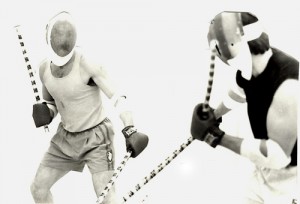
There will always be happy museum and happy history collectors, who collect ANYTHING from ANYBODY. And then those who like to sort-of, name-drop stuff like – “at this point, Roohan moved his kneecap this way, while Roohan kept his meniscus right here…” I can talk some of that artsy smack too, just from training years osmosis. I can delight the esoteric fanatics with these tidbits of meniscus positioning. I can also tell you that Ed Kranepool played first base for the Mets in the 1960s. Hey! I do know stuff! But how useful is it?)
Annnnd with that idea? I started constructing the generic PAC course. Pacific Archipelago Concepts, an irreverent, skeptical look at the related core of those related arts. This includes all the big systems in the Pacific Ocean. A lot of this work had been done, like with Kajukenbo (karate, jujitsu, kenpo, boxing).
This clean, generic, non-worship approach did not make me popular with some existing FMA entities, (some are cult-like) in fact I was suddenly shunned by some. And in the seminar business, it is still not my most popular or even my favorite course to teach, as I usually cover generic “combatives” for lack of a better term. But hey, FMA is fun to do, good exercise, a hobby with numerous abstract mental and physical benefits. And when asked to, I will happily cover it. I feel like if I can spread the core-foundation. Then anyone can more quickly blend into any FMA system they wish to pursue.
(By the way, I carried this “core” perspective over to combatives. In a way, this “double stick epiphany” in 1993 was an important idea in more ways than one. It gave me a mission. A purpose. A vision if you will. My pursuit, my study, my interest, my goal, is the universal generic.)
Back to 1993! I later asked that friend back in 1993,
“How was the _______ double stick seminar?”
“It was great!” he said, “We did 30 drills. Most of them we already do, others just a little different here and there.”
Already do? Imagine that!
********
Hock’s email is hock@hockscqc.com
Get the full info on the PAC-FMA course right here, click here